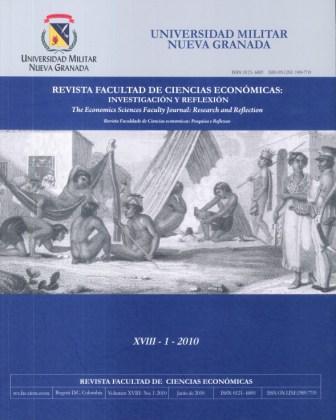Techno-economic paradigm of electric sector in Colombia through technological, organizational, financial and marketing innovations: case of isa s.a.
Abstract
This paper presents a review to historical development of electric sector in Colombia since the ends of XIX century until beginning of XXI century. The analysis is focused on the evolution of various technological innovations of organizational, fi nancial and marketing type. This paper provides a methodological advance for historical following of electric markets, which help to solve the problem of technological diffusion effect of industrialized countries toward undeveloped countries. It was examined if Colombia has had longer periods of technological diffusion and, if this process is showed in longer transition technological progress overlapping waves comparing to what happens in other more developed markets. We found that Colombia presents a delay in its technological development cycle and one fi rst technological wave is now in its maturity phase. The ISA S.A. enterprise group is taken as an example of this processDownloads
Languages:
esReferences
Acemoglu, D. Robinson, J. & Jhonson, S. (2005) Institutions as the Fundamental cause of Long-Run Growth, Handbook of Economic Growth.
Arocena, R. & Sutz J. (2002). Innovation Systems and Developing Countries, DRUID (Danish Research Unit for Industrial Dynamics. Working paper No. 02-05. Disponible en: http:// www.druid.dk/uploads/tx_picturedb/wp02-05.pdf
Ávila, R. & Hernández, I. (2005) Evolución del Sector Eléctrico Colombiano: Co-evolución de Innovaciones Tecnológicas, Organizacionales y Financieras. En: Revista Mundo Eléctrico No. 60. Julio a Septiembre de 2005. Separata de Investigación y Desarrollo. Pág. 49-53.
Carney, M. & Gedalovijc, E. (2000). The co-evolution of institutional environments and organizational strategies: the rise of family business groups in the ASEAN region. International Journal of Innovation Management.
EAFIT (2004). Asesoría para la Estimación de las Mejoras en Productividad Periódicas que logran las Firmas en las Actividades de transmisión de Energía Eléctrica, Sistema Nacional de Transporte de Gas, y Transporte, Almacenamiento y Distribución de GLP. Medellín.
Freeman, Ch. & Perez, C. (1988), “Structural crises of adjustment: business cycles and investment behaviour”, En: G. Dosi, et al., Op.cit.
García, M., Dyner, I., Botero, S., Hernández, I., Suárez, C. & Ávila, R. (2006). Desarrollo de sistemas de seguimiento a mercados eléctricos internacionales: aplicación a los países de la región andina, Bogotá: Universidad Nacional de Colombia. Facultad de Ciencias Económicas.
Goldschmidt, R. (1940). “’An empirical evolutionary generalization’ viewed from the standpoint of phenogenetics”. Am. Nat. 80: 305.
Gowdy, J.M. (1994) Coevolutionary Economics: The economy society and the environment. Kluwer Academic Publishers. Dordrecht.
Hernández, I. (2004) “Los modelos de difusión evolucionista. Una aproximación institucional”, Cuadernos de Economía, v. XXIII, n. 40, Bogotá, páginas 79-110.
Hernández, I. (2008) Empresa, Innovación y Desarrollo. Universidad Nacional de Colombia. Facultad de Ciencias Econó- micas, Grupo de Investigación en Economía Evolucionista e Institucional.
Hodgson, G.M. (1993). Economics and Evolution: Bringing back life into economics. Polity Press and University of Michigan Press. Cambridge and Ann Arbor.
ISA S.A. (2002) El Sector Eléctrico Colombiano: Orígenes, Evolución y Retos. Un siglo de Desarrollo (1882-1999).
Interconexión Eléctrica. S.A Levinthal, D. & Myatt, J. (1994). Co-evolution of capabilities and industry: The evolution of mutual fund processing Strategic.
Management Journal. Lewin, A., Long, C. & Carroll, T. (1999) The Coevolution of New Organizational Forms. En: Organization Science, Vol. 10, No. 5, (Sep. - Oct., 1999), pp. 535-550.
Lipczynski, J. & J. Wilson, (2001). Industrial Organization - An analysis of Competitive Markets, Prentice Hall, London - New York.
Machado, F. M. (1997). Gestión tecnológica para un salto en el desarrollo industrial. Madrid.
Metcalfe, S. (1998). Evolutionary Economics and Creative Destruction. The Graz Schumpeter Lectures. London & New York: Routledge.
Metcalfe, S. (2000). Restless Capitalism: Increasing Returns and Growth in Enterprise Economics. Centre for Research on Innovation and Competition.
Mokyr, J. (1990). The Lever of Riches, Technological Creativity and Economic Progress, New York, Oxford University Press.
Nelson, R. R. (1968). A Diffusion Model of International Productivity Differences in Manufacturing Industry. American Economic Review. 58(5), 1219-1248.
Nelson, R. R. (1995). “Recent Evolutionary Theorizing About Economic Change” Journal of Economic Literature, Vol. XXXIII, March.
Nelson, R. R. (2000, mayo 2). On the complexities and Limits of Market Organization. Columbia University. Conferencia presentada en el Centro para la Investigación en Innovación y Competencia, Universidad de Manchester.
Nelson, R. R. (2002). “The problem of market bias in modern capitalist economies,” Industrial and Corporate Change, Oxford University Press, vol. 11(2), pages 207-244. Norgaard, R.B. (1984). Coevolutionary Development Potential. Land Economics 60
Norgaard, R.B. (1994). Development Betrayed: The end of Progress and a Coevolutionary Revisioning of the future. Routledge, London and New York.
Nooteboom, B. (1999). Innovation and inter-fi rm linkages: New implications for policy, Research Policy, 28 Pp: 793-805.
OECD. (1996). Manual de Frascati. Medición de las actividades científicas y tecnológicas. París, OECD.
Pavón, J. & Hidalgo, A. (1997) Gestión e Innovación: Un enfoque estratégico. Madrid: Pirámide.
Pérez, C. (2000) “El cambio tecnológico y las oportunidades de desarrollo como objetivo móvil” Mesa Redonda de Alto Nivel sobre Comercio y Desarrollo: Orientaciones para el siglo XXI Bangkok, 12 de febrero.
Pérez, C. (2002) Revoluciones Tecnológicas y paradigmas tecno-económicos como armazones para diseñar la política industrial.
Pérez, C. (2003). Technological Revolutions and Financial Capital. The Dynamics of Bubbles and Golden Ages. Cheltenham, UK: Edward Elgar.
Pérez, C. (2005) Revoluciones Tecnológicas y Capital Financiero: La dinámica de las grandes burbujas fi nancieras y las épocas de bonanza. Siglo XXI editores, México.
Porter, M. (1982). Estrategia Competitiva. Cía. Editorial Continental, México.
Rogers, R.W. (1983). Cognitive and physiological processes in fear appeals and attitude change: A revised theory of protection motivation. In J. Cacioppo & R. Petty (Eds.), Social Psychophysiology. New York: Guilford Press.
Sanclemente, C. (1993). Desarrollo y Crisis del Sector Eléctrico Colombiano 1890-1993. Empresa Editorial Universidad Nacional de Colombia. Bogotá.
Schumpeter, J. (1935) Análisis del cambio económico. USA, the Review of Economics Statistics. Vol XVII no. 4. Pp 2-10. Traducido al Español y Publicado en Ensayos sobre el Ciclo Económico. Fondo de Cultura Económica, México.
Tushman, M. (1977)”A Political Approach to Organizations: A Review and Rationale.” The Academy of Management Review 2, no. 2: 206-216.
Vargas, M., Malaver, F. & Zerda, A. (2003) La innovación tecnológica en la industria colombiana, Observatorio Colombiano de Ciencia y Tecnología, Colciencias, Bogotá.
Weise, P. (1997) Evolución Económica y Auto-organización. Traducido del alemán por Jesús Gualdrón. En: Hojas Económicas. Revista Facultad de Economía Universidad Autónoma de Colombia.












